by Lucia Longhi // Dec. 17, 2021
With a practice that finds its origins in the funny and imaginative nature of illustration and cartoons, American artist Rachel Youn has developed a language made of kinetic installations that move like creatures with a life of their own. Their works arise from the recovery of objects that, in a sense, have missed their purpose: the artist sources materials with a history of aspiration and failure through secondhand shopping. Youn rescues electric massagers from suburban limbo, fastening artificial plants to the machines to create absurd, witty, sometimes erotic sculptures. Haunted by their immigrant father’s pursuit of the American Dream, their work identifies with the replica that earnestly desires to be real, and the failed object that simulates care and intimacy. Sometimes bizarre and clumsy, this witty choreography of animated sculptures reflects deeply human qualities. A liberated expressiveness, accompanied by an inherent and sometimes unintentional humor, serves to accept the tension and unpredictability of life. Thus, through humor, Youn delivers to the public personal and collective feelings related to socio-political aspects such as queerness, failed social standards and a “cosmic loneliness” rooted in their biography.
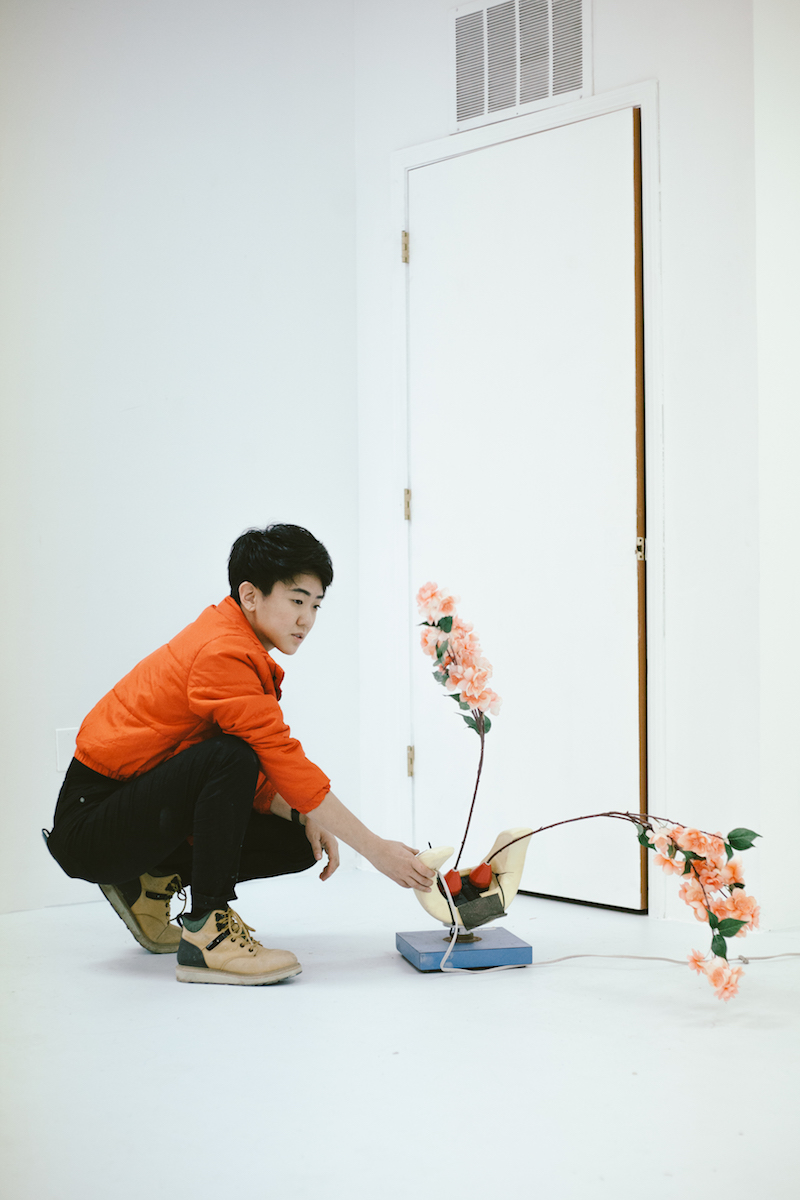
Portrait of Rachel Youn // Photo by Krista Valdez
Lucia Longhi: Instead of starting from the materials you collect and use, I would love to first ask you: what drives you to make art? What are the contents you want to convey and which topics play a crucial role in your art?
Rachel Youn: My first love was drawing, and I was especially drawn to cartoons and animation because they could express feelings and actions beyond the limitations of reality. I think it makes a lot of sense now looking at the work I make and the zany and animated qualities my sculptures have. Lately, I’ve been understanding my art and process as a way to express what my body cannot. I grew up in a conservative, religious immigrant household in predominantly white regions of the United States, so I generally felt a sense of loneliness and desire for belonging that I couldn’t quite achieve. While social/political themes are not always aesthetically at the forefront of my work, I tend to think about themes of queerness, failure and “cosmic loneliness”—a term my father used to describe his experience in the US away from his family in Korea. As reserved and quiet as I grew up, I think that’s why my sculptures are so opposite and are able to flail around wildly with bright colors. I am haunted by a fear of dancing in public spaces, so it’s only natural that my sculptures are able to do so freely. Installations allow me to envelop viewers in a colorful, fervent space, to welcome them into the world of my sculptures.
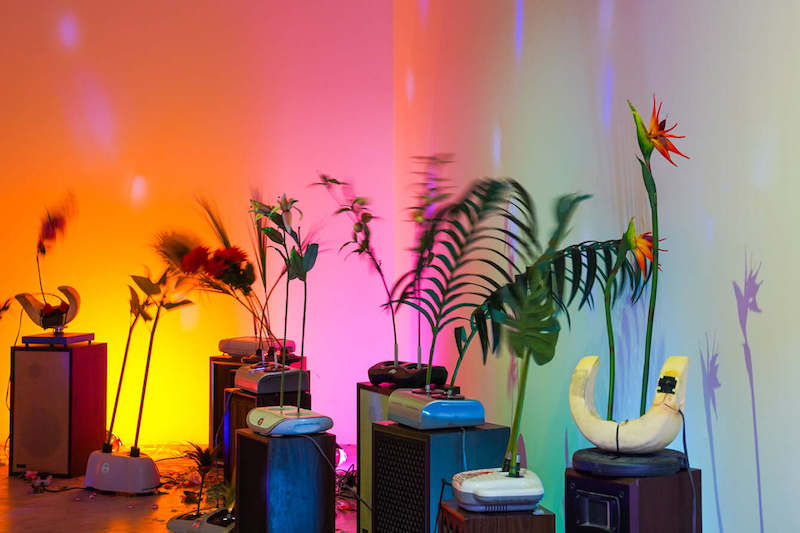
Rachel Youn: ‘Gather,’ 2020, massager, artificial plants, speaker, sound // Photo by Dusty Kessler
LL: In fact, your recent exhibition ‘Gather’ at the Contemporary Art Museum in St. Louis (Great Rivers Biennial 2020) looked almost like an oniric, playful world, a sort of fun park, or a dance floor, inhabited by colorful games and weird creatures. You choose to work with objects that you find in marketplaces and second hand shops: what fascinates you about these vernacular, everyday things? Which ones do you like the most and look for? And: why flowers and plants?
RY: I’m interested in objects that were once desired and then at some point failed to live up to their expectations of function and were thus resold. I find myself sympathizing with things that are donated or thrown away, and I like to think that I’m rescuing these massagers and appliances from a doomed fate and freeing them to perform an entirely different act. These massagers were meant to emulate the sensation and warmth of human touch and care without ever stopping, which makes it even more tragic that they are no longer wanted. I also became interested in fake flowers and plants as objects we purchase to present the idea of fresh cut flowers or nature or bounty, yet inside we know they are plastic and manufactured. These plants, intended to lie still and be looked at and appreciated, now wildly spin, shake and smack into each other as if truly alive.
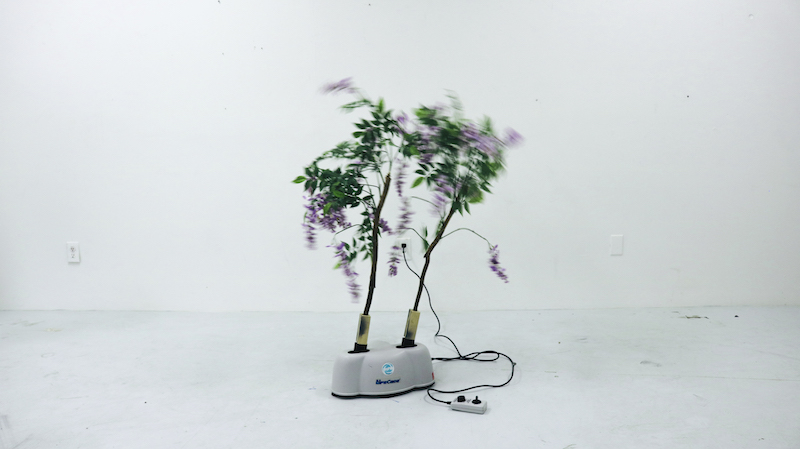
Rachel Youn: ‘Headbang,’ 2021, massager, artificial plants // Courtesy the artist
LL: Your installations are often in motion, and this makes them look almost like creatures with their own personality. You choose to make them move, to animate them: what meaning does movement have for you, both from a formal and conceptual point of view?
RY: My earlier work was based in soft sculpture. I loved how the soft forms of normally rigid objects could convey a pathetic and humorous feeling, so I sought to bring more of an animated quality to my work. I turned to using massager motors and fake plants, which brought such a lively quality to the work. Through movement, the sculptures call a lot of attention to themselves but also have a level of relatability—often they resemble limbs or bodies moving and thrashing about. I like providing a way for the viewer to identify with something that is technically nonliving but shows lively qualities. I think about how I used to animate my stuffed animals with my hands to make them seem real. I knew they weren’t alive, but I still felt a very real love for them.
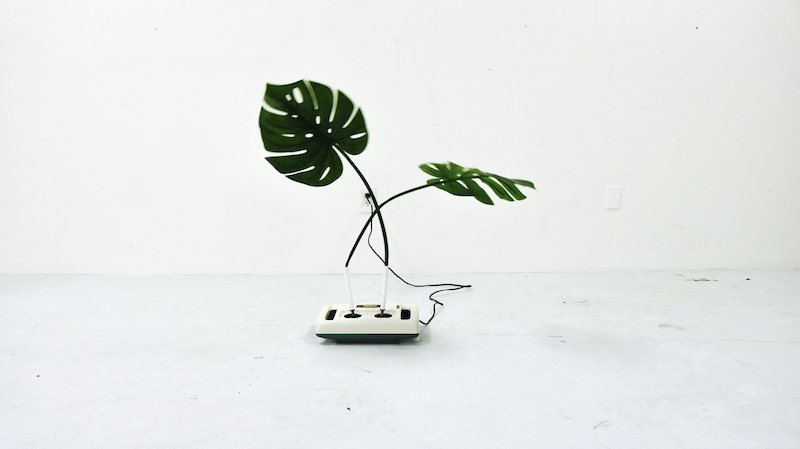
Rachel Youn: ‘Wheeze,’ 2020, massager, artificial plants // Courtesy the artist
LL: Your works indeed look lively and witty: motion and colors prompt playfulness, sometimes awkwardness, but also amusement and distraction. Do you intentionally infuse a sense of humor into your installations, or does it come out as a by-product? Does it also mirror your personality, or maybe your vision of the world?
RY: I think humor has always been a by-product of my work, but I don’t try to use work to tell a joke so that there is a punchline you must understand. I like leaving interpretation open—some people find the sculptures disturbing or sad and pathetic, and those are completely valid readings. The awkwardness of the sculptures feels very true to my personality—I’m awkward but I like to make people laugh, as a way to break the ice. It’s my way of relating to people I don’t know. I like creating a space where it’s okay to laugh, especially given how serious and cryptic contemporary art can sometimes be. One of my favorite actors is Jackie Chan, who defined his own unique style of martial arts that uses physical comedy and involves adapting to his surroundings. He never hides facial expressions—he lets the audience know that he’s bewildered or frightened or hurt. He doesn’t emit the same stoicism and calm of Bruce Lee, but that’s what makes him so lovable and unique.
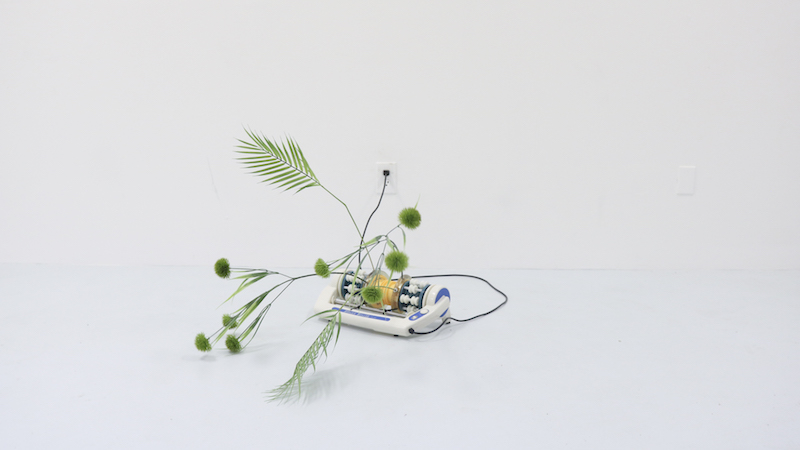
Rachel Youn: ‘Adoration,’ 2020, massager, artificial plants // Courtesy the artist
LL: In socio-politically engaged art, humor is often a lens for pointing out situations of inequality or injustice. In your work, humor doesn’t seem to have that didactic tone, nor overt satire. So what is the added value that humor brings to your work, and what does it allow you to explore that you otherwise could not without it?
RY: When I think about the position of queer people or racial minorities in larger society, there’s a certain expectation of achieving perfection or success defined by the dominant culture. This standard is unrealistic to try to abide by and perhaps one worth completely abandoning. Life is messy and full of failures and nothing ever really goes according to plan, and I think that humor puts this relatable notion out front and center. There’s a really beautiful gray space in humor. People laugh when they’re uncomfortable or they laugh to break tension. In ‘The Queer Art of Failure,’ Jack Halberstam talks about reimagining the concept of failure as a new and alternative mode of being. I like finding space for my sculptures to not just entertain like jesters, but also to allow for more complex emotions like pity and sympathy. Humor is the open door that beckons the viewer in. The sculptures aimlessly flail about ad infinitum until the motor eventually burns out, and I think that’s a great metaphor for how I perceive my own life.
This article is part of our feature topic of ‘Humor.’ To read more from this topic, click here.






















